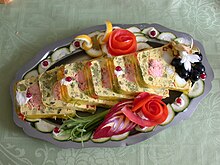Terrine (food)

A terrine (French pronunciation: [tɛ.ʁin]), in traditional French cuisine, is a loaf of forcemeat or aspic, similar to a pâté, that is cooked in a covered pottery mold (also called a terrine) in a bain-marie.[1][2][3] Modern terrines do not necessarily contain meat or animal fat, but still contain meat-like textures and fat substitutes, such as mushrooms and pureed fruits or vegetables high in pectin.[4] They may also be cooked in a wide variety of non-pottery terrine moulds, such as stainless steel, aluminium, enameled cast iron, and ovenproof plastic.[5]
Terrines are usually served cold[6] or at room temperature. Most terrines contain a large amount of fat, although it is often not the main ingredient, and pork; many terrines are made with typical game meat, such as pheasant and hare.[7] In the past, terrines were under the province of professional charcutiers, along with sausages, pâtés, galantines, and confit.[8] Less commonly, a terrine may be another food cooked or served in the cooking dish called a 'terrine'.[6]
See also
[edit]References
[edit]- ^ Trésor de la langue française, s.v.
- ^ Oxford English Dictionary, s.v.
- ^ The Culinary Institute of America (CIA). (2012). Garde Manger: The Art and Craft of the Cold Kitchen, 4E (p. 678). Hoboken, NJ: John Wiley & Sons, Inc.
- ^ The Culinary Institute of America (CIA). (2012). Garde Manger: The Art and Craft of the Cold Kitchen, 4E (p. 300). Hoboken, NJ: John Wiley & Sons, Inc.
- ^ Bolat, Jeff. "Food saving expert". Retrieved 26 November 2022.
- ^ a b "Terrine". Dictionary.com. Retrieved March 21, 2017.
- ^ S. Beaty - Pownall (1902). The "Queen" Cookery Books No. 5 - Meats and Game. London: Horace Cox. pp. 225–229. Retrieved 16 August 2017.
- ^ The Culinary Institute of America (CIA). (2012). Garde Manger: The Art and Craft of the Cold Kitchen, 4E (p. xiii). Hoboken, NJ: John Wiley & Sons, Inc.
